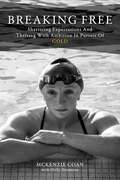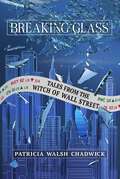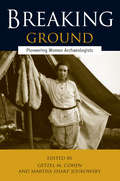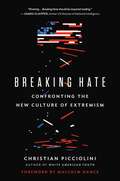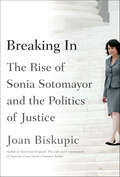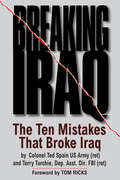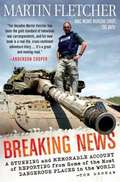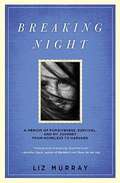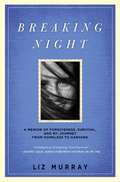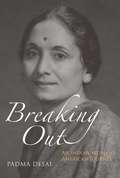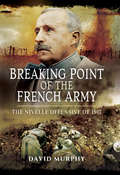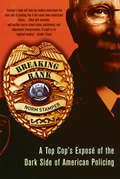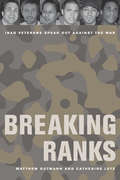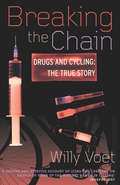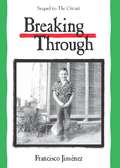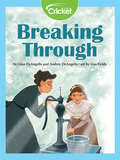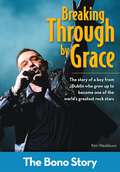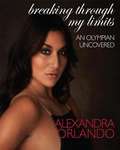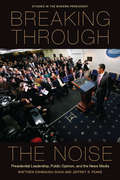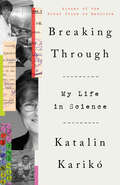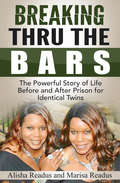- Table View
- List View
Breaking Free: Shattering Expectations and Thriving with Ambition in Pursuit of Gold
by McKenzie Coan Holly Neumann Kara Ayers<p><p>"I have no interest in living my life like a China doll." <p><p>McKenzie Coan is an elite athlete. A world champion. A Paralympic gold medalist. A world record holder. And she's not done yet. <p><p>In Breaking Free, McKenzie tells how she finds strength through swimming, despite the limited expectations placed on her by having osteogenesis imperfecta, or brittle bone disease. With her graceful freestyle stroke and never-quit attitude, McKenzie breaks through the barriers of disability and lives a life of hope on the Paralympic stage and beyond. <p><p>"Keep going. It is so worth it. I've had my hard moments in the pool before, too, but keep going. A champion's mindset isn't always about breaking records and winning gold medals. What makes a champion is going out on your lowest day or on the day that you fail or the day that you lose and still giving your all, still giving your best and refusing to quit."
Breaking Free: True Stories of Girls Who Escaped Modern Slavery
by Abby SherBreaking Free: True Stories of Girls Who Escaped Modern Slavery, by award-winning author Abby Sher, explores the global issue of human sex trafficking from a survivor's point of view. It recounts the harrowing stories of three courageous women—Somaly Mam, Minh Dang, and Maria Suarez—who were all forced into sexual slavery as children. After escaping their captors, these three women could easily have become voiceless victims, lost to the horrors of their own histories; instead, they have each become leading advocates and activists in the anti-trafficking movement.With help from Somaly, Maria, Minh, and many other survivors and counselors, Sher tells the riveting story of what it means to be liberated from sexual trafficking and find the trust and conviction to help educate new survivors. Told with breath-taking honesty and simplicity, Breaking Free: True Stories of Girls Who Escaped Modern Slavery sends the message that, even in the most tragic circumstances, the unwavering hope and compassion of the human spirit can and will shine through.
Breaking Glass: Tales from the Witch of Wall Street
by Patricia Walsh ChadwickKicked out of a cult at seventeen, Patricia Walsh Chadwick started on the bottom rung of the ladder in the world of business and worked her way to the top—breaking through the glass ceiling to become a global partner at Invesco.Patricia grew up in a religious community-turned-cult in the Boston area. At the age of seventeen, she was forced out of her home, leaving behind her entire family, and without access to higher education. From her first job as a receptionist at a brokerage firm, she clawed her way up the ladder—rung by rung—in that bastion of male chauvinism: Wall Street. By going to college at night, she achieved her degree in economics from Boston University, and from there, she headed to New York City. With a drive that earned her the moniker &“Witch of Wall Street,&” she rose from the ranks of research analyst to portfolio manager, where she was responsible for billions of dollars in pension and endowment assets. A turning point in her life was giving birth to twins at the age of forty-five, and she continued forward in her career, becoming a global partner at Invesco. At the turn of the millennium, she left Wall Street behind and embarked on a second career as a corporate board director.
Breaking Ground
by Getzel M. Cohen Martha Sharp Joukowsky"At the close of the Victorian era, two generations of intrepid women abandoned Grand Tour travel for the rigors of archaeological expeditions, shining the light of scientific exploration on Old World antiquity. Breaking Ground highlights the remarkable careers of twelve pioneers-a compelling narrative of personal, social, intellectual, and historical achievement. " -Claire Lyons, The Getty Museum "Behind these pioneering women lie a wide range of fascinating and inspiring life stories. Though each of their tales is unique, they were all formidable scholars whose important contributions changed the field of archaeology. Kudos to the authors for making their stories and accomplishments known to us all!" -Jodi Magness, University of North Carolina, Chapel Hill This book presents twelve fascinating women whose contributions to the development and progress of Old World archaeology---in an area ranging from Italy to Mesopotamia---have been immeasurable. Each essay in this collection examines the life of a pioneer archaeologist in the early days of the discipline, tracing her path from education in the classics to travel and exploration and eventual international recognition in the field of archaeology. The lives of these women may serve as models both for those interested in gender studies and the history of archaeology because in fact, they broke ground both as women and as archaeologists. The interest inherent in these biographies will reach well beyond defined disciplines and subdisciplines, for the life of each of these exciting and accomplished individuals is an adventure story in itself
Breaking Hate: Confronting the New Culture of Extremism
by Christian PiccioliniFrom a onetime white-supremacist leader now working to disengage people from extremist movements, Breaking Hate is a "riveting" (James Clapper), "groundbreaking" (Malcolm Nance), "horrifying [but] hopeful" (S.E. Cupp) exploration of how to heal a nation reeling from hate and violence.Today's extremist violence surges into our lives from what seems like every direction -- vehicles hurtling down city sidewalks; cyber-threats levied against political leaders and backed up with violence; automatic weapons unleashed on mall shoppers, students, and the faithful in houses of worship. As varied as the violent acts are the attackers themselves -- neo-Nazis, white nationalists, the alt-right, InCels, and Islamist jihadists, to name just a few. In a world where hate has united communities that traffic in radical doctrines and rationalize their use of violence to rally the disaffected, the fear of losing a loved one to extremism or falling victim to terrorism has become almost universal.Told with startling honesty and intimacy, Breaking Hate is both the inside story of how extremists lure the unwitting to their causes and a guide for how everyday Americans can win them-and our civil democracy-back. Former extremist Christian Picciolini unravels this sobering narrative from the frontlines, where he has worked for two decades as a peace advocate and "hate breaker." He draws from the firsthand experiences of extremists he has helped to disengage, revealing how violent movements target the vulnerable and exploit their essential human desires, and how the right interventions can save lives.Along the way, Picciolini solves the puzzle of why extremism has come to define our era, laying bare the ways in which modern society-from "fake news" and social media propaganda to coded language and a White House that inflames rather than heals-has polarized and radicalized an entire generation.Piercing, empathetic, and unrestrained, Breaking Hate tells the sweeping story of the challenge of our time and provides a roadmap to overcoming it.
Breaking History: A White House Memoir
by Jared KushnerJared Kushner was one of the most consequential presidential advisers in modern history. For the first time, he recounts what happened behind closed doors during the Trump presidency. <p><p>Few White House advisors have had such an expansive portfolio or constant access to the president. From his office next to Trump, senior adviser Jared Kushner operated quietly behind the scenes, preferring to leave the turf wars and television sparring to others. Now, Kushner finally tells his story—a fast-paced and surprisingly candid account of how an earnest businessman with no political ambitions found himself pulled into a presidency that no one saw coming. <p><p>Breaking History takes readers inside debates in the Oval Office, double-crosses at the United Nations, tense meetings in Arab palaces, high-stakes negotiations, and the daily barrage of leaks, false allegations, investigations, and West Wing infighting. A true historical thriller, this book is not your typical political memoir. Kushner details Washington’s intense resistance to change and reveals how he broke through the stalemates of the past. An outsider among outsiders, Kushner was a results-driven executive among beltway power brokers. He questioned old assumptions and delivered unprecedented results on trade, criminal justice reform, production of COVID-19 vaccines, and Middle East peace. His successful negotiation of the Abraham Accords, the most significant diplomatic breakthrough in 50 years, earned him a nomination for the Nobel Peace Prize. Written by one of the few people by Trump’s side from his trip down the golden escalator to his final departure from Andrews Air Force Base, Breaking History provides the most honest, nuanced, and definitive understanding of a presidency that will be studied for generations. <p> <b>New York Times Bestseller</b>
Breaking In: The Rise of Sonia Sotomayor and the Politics of Justice
by Joan Biskupic"I knew she'd be trouble."So quipped Antonin Scalia about Sonia Sotomayor at the Supreme Court's annual end-of-term party in 2010. It's usually the sort of event one would expect from such a grand institution, with gentle parodies of the justices performed by their law clerks, but this year Sotomayor decided to shake it up—flooding the room with salsa music and coaxing her fellow justices to dance. It was little surprise in 2009 that President Barack Obama nominated a Hispanic judge to replace the retiring justice David Souter. The fact that there had never been a nominee to the nation's highest court from the nation's fastest growing minority had long been apparent. So the time was ripe—but how did it come to be Sonia Sotomayor? In Breaking In: The Rise of Sonia Sotomayor and the Politics of Justice, the veteran journalist Joan Biskupic answers that question. This is the story of how two forces providentially merged—the large ambitions of a talented Puerto Rican girl raised in the projects in the Bronx and the increasing political presence of Hispanics, from California to Texas, from Florida to the Northeast—resulting in a historical appointment. And this is not just a tale about breaking barriers as a Puerto Rican. It's about breaking barriers as a justice. Biskupic, the author of highly praised judicial biographies of Justice Antonin Scalia and Justice Sandra Day O'Connor, now pulls back the curtain on the Supreme Court nomination process, revealing the networks Sotomayor built and the skills she cultivated to go where no Hispanic has gone before. We see other potential candidates edged out along the way. And we see how, in challenging tradition and expanding our idea of a justice (as well as expanding her public persona), Sotomayor has created tension within and without the court's marble halls. As a Supreme Court justice, Sotomayor has shared her personal story to an unprecedented degree. And that story—of a Latina who emerged from tough times in the projects not only to prevail but also to rise to the top—has even become fabric for some of her most passionate comments on matters before the Court. But there is yet more to know about the rise of Sonia Sotomayor. Breaking In offers the larger, untold story of the woman who has been called "the people's justice."
Breaking Iraq: The Ten Mistakes that Broke Iraq
by Ted Spain Terry TurchieThis is an important book, because it gives us the unvarnished account of one brigade commander s tour of duty in Baghdad during the tumultuous first year of the American occupation," writes Tom Ricks in the Foreword. "From it the reader will learn much about what went wrong in Iraq, and also what was wrong with the American military. There, also, are valuable lessons for anyone about command in any war." Ten decisions in Washington and in the battle zone broke Iraq; only cosmetic cement holds it together today. The crack started in Washington and widened early in the battle zones. The authors, who know much about law enforcement and the maintenance of order, identify those decisions. Starting with Defense Secretary Rumsfeld's failure to plan for post-invasion law and order, the appointment of inept generals and political opportunists,the confusion spawned by the cobweb of agreement woven by the Coalition of the Willing to the development of a police force that was slowed by political interference has created an effect that may be longer lasting than any political cement can hold together This is an inside look at how the failure to understand and implement basic fundamentals in creating structure in nation building, can slow the process or even invite failure.
Breaking New Ground: A Personal History
by Lester R. BrownAn inspirational memoir tracing Lester Brown's life from a small-farm childhood to leadership as a global environmental activist. Lester R. Brown, whom the Washington Post praised as "one of the world's most influential thinkers," built his understanding of global environmental issues from the ground up. Brown spent his childhood working on the family's small farm. His entrepreneurial skills surfaced early. Even while excelling in school, he launched with his younger brother a tomato-growing operation that by 1958 was producing 1.5 million pounds of tomatoes. Later, at the U.S. Department of Agriculture, Brown emphasized the need for systemic thinking. In 1963 he did the first global food supply and demand projections to the end of the century. While on a brief assignment in India in 1965, he pieced together the clues that led him to sound the alarm on an impending famine there. His urgent warning to the U.S. and Indian governments set in motion the largest food rescue effort in history, helping to save millions of lives. This experience led India to adopt new agricultural practices, which he helped to shape. Brown went on to advise governments internationally and to found the Worldwatch and Earth Policy institutes, two major nonprofit environmental research organizations. Both brilliant and articulate, through his many books he has brought to the fore the interconnections among such issues as overpopulation, climate change, and water shortages and their effect on food security. His 1995 book, Who Will Feed China?, led to a broad restructuring of China's agricultural policy. Never one to focus only on the problem, Brown always proposes pragmatic, employable solutions to stave off the unfolding ecological crises that endanger our future.
Breaking News: A Stunning and Memorable Account of Reporting from Some of the Most Dangerous Places in the World
by Martin FletcherMartin Fletcher doesn't claim to be a hero. Yet he didn't flinch, either. During three decades covering wars, revolutions, and natural disasters, Fletcher worked his way from news agency cameraman to top network correspondent, facing down his own fears while facing up to mass killers, warlords, and murderers. With humor and elegance, Fletcher describes his growth from clueless adventurer to grizzled veteran of the world's battlefields. His working philosophy of "Get in, get close, get out, get a drink," put him repeatedly in harm's way, but he never lost sight of why he did it. In a world obsessed with celebrities, leaders, and wealth, Fletcher took a different route: he focused on those left behind, those paying the price. He answers the question: Why should we care? These extraordinary, real-life adventure stories each examine different dilemmas facing a foreign correspondent. Can you eat the food of a warlord, who stole it from the starving? Do you listen politely to a terrorist threatening to blow up your children? Do you ask the tough questions of a Khmer Rouge killer, knowing he is your only ticket out of the Cambodian jungle? And above all, how do you stay sane faced with so much pain?
Breaking Night: A Memoir of Forgiveness, Survival, and My Journey from Homeless to Harvard
by Liz MurrayThe stunning memoir of a young woman who at age 15 was living on the streets but survived to make it to Harvard.
Breaking Night: A Memoir of Forgiveness, Survival, and My Journey from Homeless to Harvard
by Liz MurrayIn the vein of The Glass Castle, Breaking Night is the stunning memoir of a young woman who at age fifteen was living on the streets, and who eventually made it into Harvard. Liz Murray was born to loving but drug-addicted parents in the Bronx. In school she was taunted for her dirty clothing and lice-infested hair, eventually skipping so many classes that she was put into a girls' home. At age fifteen, Liz found herself on the streets when her family finally unraveled. She learned to scrape by, foraging for food and riding subways all night to have a warm place to sleep. When Liz's mother died of AIDS, she decided to take control of her own destiny and go back to high school, often completing her assignments in the hallways and subway stations where she slept. Liz squeezed four years of high school into two, while homeless; won a New York Times scholarship; and made it into the Ivy League. Breaking Night is an unforgettable and beautifully written story of one young woman's indomitable spirit to survive and prevail, against all odds.
Breaking Out
by Padma DesaiPadma Desai grew up in the 1930s in the provincial world of Surat, India, where shehad a sheltered and strict upbringing in a traditional Gujarati Anavil Brahmin family. Her academicbrilliance won her a scholarship to Bombay University, where the first heady taste of freedom in thebig city led to tragic consequences -- seduction by a fellow student whom she was then compelled tomarry. In a failed attempt to end this disastrous first marriage, she converted toChristianity. A scholarship to America in 1955 launched her on her long journey toliberation from the burdens and constraints of her life in India. With a growing self-awareness andtransformation at many levels, she made a new life for herself, met and married the celebratedeconomist Jagdish Bhagwati, became a mother, and rose to academic eminence at Harvard andColumbia. How did she navigate the tumultuous road to assimilation in Americansociety and culture? And what did she retain of her Indian upbringing in the process? This brave andmoving memoir -- written with a novelist's skill at evoking personalities, places, and atmosphere,and a scholar's insights into culture and society, community, and family -- tells a compelling andthought-provoking human story that will resonate with readers everywhere.
Breaking Point
by Suzy SpencerFrom the New York Times–bestselling author of The Fortune Hunter, “a classic true-crime tapestry” (Ron Franscell, bestselling author of The Darkest Night). Andrea Yates, a suburban Houston mother of five, horrified the nation on June 20, 2001, when she dialed 911 and said, “I killed my children.” While her husband Rusty, a NASA engineer, was at work, Andrea filled the family bathtub with water and systematically drowned their children, ages six months to seven years. As her eldest child lay lifeless in the bathtub and the bodies of her four youngest rested in her bed, Andrea, a devoted Christian wife and former nurse, called the police to confess her sin. The investigations by the prosecutors, by the defense, and by the press delved deeper into Andrea’s mind and history, revealing a disturbing web of suicidal tendencies, depression, and psychoses. While her husband struggled between his overwhelming grief and his loyalty to his incarcerated wife, an outraged nation asked one question after another: How could anyone do this? What would drive a mother to kill her children? Drawing from hundreds of hours of interviews, court testimony, and medical records, including new access to psychiatric and legal files, Breaking Point traces the story of an all-American family struggling with the darkness of a mental illness that twisted a loving mother into a killer obsessed with hellfire.
Breaking Point of the French Army: The Nivelle Offensive of 1917
by David MurphyThis historical analysis of the ill-fated Franco-British operation reveals how it nearly spelled defeat for the Triple Entente in WWI. In December of 1916, General Robert Nivelle was appointed Commander-in-Chief of the French armies fighting the Germans on the Western Front. A national hero, he had enjoyed a meteoric rise to high command and public acclaim since the beginning of the Great War. In return, he proclaimed he 'had the formula' that would ensure victory and end the conflict in 1917. But his offensive was a bloody and humiliating failure for France, one that could have opened the way for French defeat. Historian David Murphy presents a penetrating, in-depth analysis of The Nivelle Offensive, demonstrating why it failed and underscoring its importance in the course of the First World War. Murphy describes how the charismatic officer used his charm and intelligence to win the support of French and British politicians, but also how his vanity and braggadocio displayed no sense of operational security. By the opening of the campaign, his plan was an open secret and he had lost the ability to critically assess the operation as it developed. The result was disaster.
Breaking Rank: A Top Cop's Exposé of the Dark Side of American Policing
by Norm StamperOpening with a powerful letter to former Tacoma police chief David Brame, who shot his estranged wife before turning the gun on himself, Norm Stamper introduces us to the violent, secret world of domestic abuse that cops must not only navigate, but which some also perpetrate. Former chief of the Seattle police force, Stamper goes on to expose a troubling culture of racism, sexism, and homophobia that is still pervasive within the twenty-first-century force; then he explores how such prejudices can be addressed. He reveals the dangers and temptations that cops face, describing in gripping detail the split-second life-and-death decisions. Stamper draws on lessons learned to make powerful arguments for drug decriminalization, abolition of the death penalty, and radically revised approaches to prostitution and gun control. He offers penetrating insights into the "blue wall of silence," police undercover work, and what it means to kill a man. And, Stamper gives his personal account of the World Trade organization debacle of 1999, when protests he was in charge of controlling turned violent in the streets of Seattle. Breaking Rank reveals Norm Stamper as a brave man, a pioneering public servant whose extraordinary life has been dedicated to the service of his community.
Breaking Ranks: Iraq Veterans Speak Out Against the War
by Matthew C. GutmannBreaking Ranks brings a new and deeply personal perspective to the war in Iraq by looking into the lives of six veterans who turned against the war they helped to fight. Based on extensive interviews with each of the six, the book relates why they enlisted, their experiences in training and in early missions, their tours of combat, and what has happened to them since returning home. The compelling stories of this diverse cross section of the military recount how each journey to Iraq began with the sincere desire to do good. Matthew Gutmann and Catherine Anne Lutz show how each individual's experiences led to new moral and political understandings and ultimately to opposing the war.
Breaking The Chain: Drugs and Cycling - The True Story
by Willy Voet-------------------------------On 8 July 1998 Festina team soigneur Willy Voet was stopped by the police. In his car were the drugs the team needed if they were to have any chance of playing a competitive part in the 1998 Tour de France. The car was searched, he was immediately arrested and so the story that has been undermining the sport of cycling since the death of Tommy Simpson in 1967, finally broke. Imprisoned for sixteen days, sacked from the Festina team and ostracised from the sport to which he had dedicated his life, Willy Voet at last was able to tell the truth. His sensational story will change cycling forever.Cocaine, amphetamines, EPO, heroin - all these are now considered not optional but necessary, not to win but just to compete in the Tour de France. Details of how these drugs are obtained, mixed together to make cocktails, administered and concealed are all included in this graphic and uninhibited account of how drugs brought cycling to its knees.
Breaking Through
by Francisco JiménezAt the age of fourteen, Francisco Jiménez, together with his older brother Roberto and his mother, are caught by la migra. Forced to leave their home in California, the entire family travels all night for twenty hours by bus, arriving at the U.S. and Mexican border in Nogales, Arizona. In the months and years that follow during the late 1950s-early 1960s, Francisco, his mother and father, and his seven brothers and sister not only struggle to keep their family together, but also face crushing poverty, long hours of labor, and blatant prejudice. How they sustain their hope, their good-heartedness, and tenacity is revealed in this moving, Pura Belpré Honor-winning sequel to The Circuit. Without bitterness or sentimentality, Francisco Jiménez finishes telling the story of his youth.
Breaking Through
by Gina DeAngelisWhen she was young, Helen Keller suffered a fever that cost her her sight and hearing. For a time, her parents let her run wild, but eventually, they hired Anne Sullivan to teach Helen. The two worked together for many years.
Breaking Through By Grace: The Bono Story (ZonderKidz Biography)
by Kim WashburnWhen love walks in the room … Awards, fame, wealth … Bono has it all. But the biggest rock star in the world has something more important, something that has guided every step of his success: faith in God. From growing up in Ireland during deadly times to performing on the largest stages in the world, Bono’s beliefs have kept him grounded and focused on what truly matters. Whether using his voice to captivate an audience or to fight for justice and healing in Africa, Bono is a champion of the lost and a hero to those who long for harmony.
Breaking Through My Limits
by Alexandra OrlandoAlexandra Orlando is an Olympic athlete who dedicated seventeen years of her life to the sport of rhythmic gymnastics, winning almost two hundred medals. Despite injury, she competed at the Beijing Olympic Games in 2008, and retired from the sport at the age of twenty-one as one of the top ten gymnasts in the world. Her incredible story is one of struggle and strength. Through it all, her family and friends watched the sport consume her; and every person that came into her life was affected by the constant fight for perfection, and the mental and physical exhaustion. Those who had the strength never left her side. And when the dust settled, a woman emerged who was stronger than she ever thought she could be. Reflecting back on her life as ""Alex the Gymnast,"" Alexandra takes a deeper look on who she was during her career, who she had to be, and how this made her the person she is today.
Breaking Through the Noise: Presidential Leadership, Public Opinion, and the News Media
by Matthew Eshbaugh-Soha Jeffrey S. PeakeModern presidents engage in public leadership through national television addresses, routine speechmaking, and by speaking to local audiences. With these strategies, presidents tend to influence the media's agenda. In fact, presidential leadership of the news media provides an important avenue for indirect presidential leadership of the public, the president's ultimate target audience. Although frequently left out of sophisticated treatments of the public presidency, the media are directly incorporated into this book's theoretical approach and analysis. The authors find that when the public expresses real concern about an issue, such as high unemployment, the president tends to be responsive. But when the president gives attention to an issue in which the public does not have a preexisting interest, he can expect, through the news media, to directly influence public opinion. Eshbaugh-Soha and Peake offer key insights on when presidents are likely to have their greatest leadership successes and demonstrate that presidents can indeed "break through the noise" of news coverage to lead the public agenda.
Breaking Through: My Life in Science
by Katalin KarikóA powerful memoir from Katalin Karikó, winner of the 2023 Nobel Prize in Physiology or Medicine, whose decades-long research led to the COVID-19 vaccines &“Katalin Karikó&’s story is an inspiration.&”—Bill Gates&“Riveting . . . a true story of a brilliant biochemist who never gave up or gave in.&”—Bonnie Garmus, author of Lessons in ChemistryA KIRKUS REVIEWS BEST BOOK OF THE YEARKatalin Karikó has had an unlikely journey. The daughter of a butcher in postwar communist Hungary, Karikó grew up in an adobe home that lacked running water, and her family grew their own vegetables. She saw the wonders of nature all around her and was determined to become a scientist. That determination eventually brought her to the United States, where she arrived as a postdoctoral fellow in 1985 with $1,200 sewn into her toddler&’s teddy bear and a dream to remake medicine. Karikó worked in obscurity, battled cockroaches in a windowless lab, and faced outright derision and even deportation threats from her bosses and colleagues. She balked as prestigious research institutions increasingly conflated science and money. Despite setbacks, she never wavered in her belief that an ephemeral and underappreciated molecule called messenger RNA could change the world. Karikó believed that someday mRNA would transform ordinary cells into tiny factories capable of producing their own medicines on demand. She sacrificed nearly everything for this dream, but the obstacles she faced only motivated her, and eventually she succeeded.Karikó&’s three-decade-long investigation into mRNA would lead to a staggering achievement: vaccines that protected millions of people from the most dire consequences of COVID-19. These vaccines are just the beginning of mRNA&’s potential. Today, the medical community eagerly awaits more mRNA vaccines—for the flu, HIV, and other emerging infectious diseases.Breaking Through isn&’t just the story of an extraordinary woman. It&’s an indictment of closed-minded thinking and a testament to one woman&’s commitment to laboring intensely in obscurity—knowing she might never be recognized in a culture that is driven by prestige, power, and privilege—because she believed her work would save lives.
Breaking Thru The Bars
by Marisa Readus Alisha ReadusIdentical twins, Alisha and Marisa Readus were living the middle class suburban dream. With hard-working parents and the best of everything, their paths were predestined for greatness. Or so it seemed…. The fast life Suburban life quickly plunged downhill after their parents’ divorce. Their new urban life took its toll as the twins approached their teenage years, and before their parents knew it, they were hanging with the wrong crowds, doing the wrong things, and recharting their life course. Alisha would be lured into life as a stripper, filled with sex, drugs, and a rotation of bad boys. While Marisa sought sex and money by any means necessary. What’s done in the dark It wouldn’t be long before the fast life caught up with the twins. After becoming embroiled in crime, their glamorous world came tumbling down. The identical twins were sentenced to prison – and torn away from their small children. It didn’t take long for these sisters to want better…and although they were hundreds of miles apart, both of them were determined to break thru the mental and physical bars, reclaim their children, rebuild their lives, and recharge their course. In a riveting, personal memoir, Alisha and Marisa share their cautionary yet inspirational tale and hopefully inspire others to break thru their own bars.
